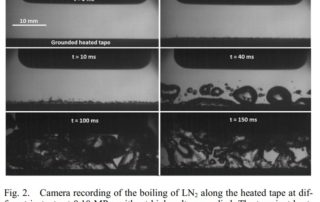Nos publications scientifiques
Dielectric properties of ceramic substrates and current developments for medium voltage applications
Why are ceramic materials (when compared to organic materials) necessary for the purpose of electric isolation in power modules, especially for medium voltage applications...
Modelling of a 25 kV-50 Hz railway infrastructure for harmonic analysis
This paper presents a methodology for the modelling of a 25 kV-50 Hz railway infrastructure, for frequencies from 0 to 5 kHz. It aims to quantify the amplifications of current and voltage harmonics generated by on-board converters into the infrastructure. A circuit is developed to model the skin effect in the overhead line for time-domain simulations. A new approach, based on state space representation and transfer functions, is also proposed to analyse the interactions between trains.
Design of a 1200 V, 100 kW Power Converter: How Good are the Design and Modelling Tools?
During the design of power converter, design mistakes must be avoided, especially for high voltage and high power converters. Simulation tools can be used to help the designers and limit the risks. This presentation will present a design flow approach used to design and validate a 1.2 kV – 100 kW DC-DC converter which was design from die to converter levels and started for a “blank page”. The presentation is organized in four parts. Firstly, the context of the work is introduced. Then, the simulation flow approach used to validate the design is presented. For this part, the presentation will focus on the system level simulation of one inverter, including the power modules. This part will highlight the main limitations of the current simulation tools found by the designers. In the third part, an enhanced approach is proposed to overcome the limitations and the first results are presented Finally, a conclusion will be presented.
Study of Turn-to-Turn Electrical Breakdown for Superconducting Fault Current Limiter Applications
The rational insulation design of a resistive superconducting fault current limiter (r-SCFCL) requires data gathered from experimental setups representative of the final apparatus. Therefore, an experimental study was performed to characterize the electrical breakdown (BD) of liquid nitrogen (LN2) in the peculiar conditions of a quenching superconducting device.
Arc appearance and cathode spot distribution in a long gap high-current vacuum arc controlled by an external axial magnetic field
An experimental study of a high-current vacuum arc (VA) generated between two static CuCr25 contacts spaced 20 or 30 mm apart was conducted to characterize the arc appearance and the cathode spot (CS) distribution.
Packaging of 10 kV SiC MOSFETs: Trade-Off Between Electrical and Thermal Performances
SiC transistors can achieve blocking voltages of 10kV and more. This makes them especially attractive for energy transmission and distribution. Although SiC devices can in theory operate at high temperature (more than 200°C), the on-state resistance of SiC MOSFETs exhibits a strong dependency on the junction temperature. As a consequence, it is shown that these transistors must actually operate at a relatively low junction temperature (less than 100°C) to increase conversion efficiency and prevent thermal runaway. This requirement for high-performance cooling systems has consequences on the packaging technology: the corresponding power modules must both offer a high voltage insulation and a low thermal resistance. In particular, there is a trade-off in the thickness of the ceramic substrate located between the SiC devices and the cooling system. We propose a new substrate structure, with raised features, which improves the voltage strength of a substrate without increasing its thickness. This structure is demonstrated experimentally.
Energy Control of Modular Multilevel Converters in MTDC Grids for Wind Power Integration
The role of Modular Multilevel Converters (MMCs) in HVDC grid greatly differs depending on whether it is an offshore or an onshore station. From the common point in their control schemes, an unexploited ability of the MMC—the controllability of the internally stored energy—is identified in both offshore and onshore applications. The virtual capacitor control, previously proposed by the authors, makes use of this degree of freedom to provide energy contribution to the DC grid. The impact of this control is demonstrated by time-domain simulations of a five-terminal HVDC grid.
HVDC protection criteria for transient stability of AC systems with embedded HVDC links
The objective of this study is to propose a methodology for the transient stability assessment of a simple but representative AC grid in case of DC fault. After validation of the methodology, some HVDC link protection criteria are defined in terms of the Critical Time to Return to Operation. These criteria will be helpful for the design of HVDC protection systems or for the sizing of future HVDC links in order to respect the constraints of the existing protection strategies.
Electrical properties of epoxy systems based on ionic liquids
In accordance with their interesting properties, ionic liquids (ILs) have attracted in the recent years a great interest in the material field. Recently, few authors have demonstrated the reactivity of ionic liquids towards epoxy in order to form new epoxy-based networks...
Design considerations for the 2- phase cooling system of a 5 MW MVDC converter
This presentation will provide an update on our current project: designing a cooler for a high power (5 MW) MVDC converter for offshore wind turbines applications. A number of constraints are imposed, mainly related to a limited volume, environmental, safety and health regulations, and of course cooling performance. Indeed, as we presented last year (ATW 2017), the silicon carbide power semiconductors used in this converter should operate at a junction temperature lower than 100 °C for better efficiency.





